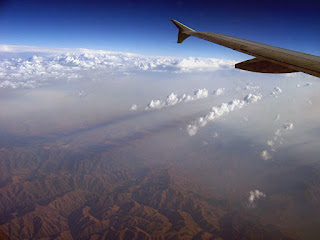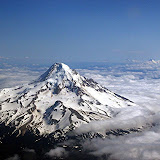How to make aerial photos from the window of an airliner 'more better.'
This is a response to the comments posted earlier. It seems there is a lot of interest in this subject! Besides setting a low ASA, (which reduces the graininess) you want to get the best f stop at the highest shutter speed. I find any shutter speed over 250th of a second guarantees I'll get rid of any vibrations (higher speeds are better in turbulence) and then I set the f stop for the smallest aperture possible without driving the shutter speed lower. As for focus, my camera, a mid - level Canon digital SLR style camera, will usually work fine on auto focus, but if it does not I set it to manual and set it to infinity.Hopefully the sun angle is low, like you would get from sunrise to around 10 am or 3 pm to sunset. The lower the angle, the more dramatic the shot as their will be more color possibilities and better contrast from shadow detail. Alas, we cannot always choose our flight for the sun angle!Your goal is to get the target image in or near the center of the image, with no parts of the airplane in sight. Try to shoot through clear sections of class if your window is smudgy, and if it is smudgy on the inside, you may be able to clean it a bit with a blanket or cloth. Yet capturing the image i just half the story. Think of it as capturing the 'raw data.' When you bring the image up on you computer, it will typically have a bluish sheen from reflectivity and shooting through the Plexiglas. If the details on the ground are strong enough you can significantly or even completley 'tune out' this image problem by increasing the brightness and contrast in even the most basic photo editor. The Google Picasa editor (free download) can do this for you, or you can use the Microsoft Photo edit suite, which I also use. The three ares I usually use to tweak a photo and dial out the glare are contrast, brightness and color temperature. Sometimes I sharpen the image with focus, if necessary. I hope that helps! If anyone gets an interesting shot they would like to share, email me at rob.bremmer@gmail.com and I'll post your photo an give you photo credits. I hope ths helps those who are interested.
onwards and upwards!
Rob Bremmer
Google Search from Why2Fly

Wednesday, July 30, 2008
Monday, July 28, 2008
Crater Lake - Aerial photos from airliner window seat

You might think you need a small plane or a big budget to take interesting aerial photographs but that isn't true! Photos taken from the seat of any airliner, with a little planning, can yield spectacular results.
These photos of Crater Lake were taken from a right-side passenger window seat in front of the wing of a Horizon Air RJ Regional Jet on a flight from Southern California to the Pacific Northwest. It does require a little planning ahead to capture such shots, for example, having a window seat is very helpful, and a clean window is important too! You also want to sit in front of the wing, as far in front as possible to maximize opportunities to see the ground. Behind the wing can be interesting, but the wing will limit your view forward and if the aircraft has wing mounted engines the thrust and exhaust gases will distort the air, ruining a clean view of any object on the ground. Sitting over the wing renders ground shots useless, but interesting cloud shots can still be obtained!
Any digital camera will work, but the better ones allow you to set a lower ASA number and maximize the quality of the photo in terms of photo size which equates to more megabytes per image. A zoom lens is helpful but not necessary. Sometimes a wide angle will give more interesting shots encompassing sky and land, yet a telephoto, while allowing the appearance of closeups, can highlight haze in the atmosphere and is more inclined to pick up shaky vibrations which blur the shot.
Don't conserve shots! Shoot like crazy; it's digital, so after the opportunity has passed by the window, you can edit away the weaker images. Remember you are traveling at over 200 miles per hour so when you see look as far ahead of the plane as you can and when you see something that looks interesting get your camera ready and start taking pictures!
I could mention that while I was taking these images I was being served complimentary chilled northwest micro-brews, a unique and classy service on the last remaining civilized airline in the United States, but that would be an entirely different story!
onwards and upwards!
Rob Bremmer
Posted by
Rob Bremmer
at
7/28/2008 11:33:00 PM
2
comments
![]()
Labels: aerial photos for anyone, Crater Lake aerial photo, digial aerial photography, good photos from an airliner window seat, Horizon Air, Oregon natural monuments
Friday, July 18, 2008
Please take the SURVEY about flying
I've added a small survey to uncover the predominant reason people don't fly as much as they could.Please take the survey, and check back later for the results.
onward and upward!
~ rob bremmer
Posted by
Rob Bremmer
at
7/18/2008 08:17:00 PM
1 comments
![]()
Labels: A survey on why to fly and why you don't fly more often. check aviation survey results often
Tuesday, July 15, 2008
"I've looked at clouds from both sides now!"


As the old song suggests, the visual beauty of clouds may be appreciated from the top looking down as well as the more traditional bottom looking up. This post is in honor of John Day, a physicist who recently passed away, and spent his life studying clouds and promoting cloud watching. I feel certain he would have enjoyed flying, leaning out an open airplane window and taking photographs of clouds from the top to compliment the view from the ground.
I only just learned of Dr. Day and his work recently. He studied clouds, wrote about clouds and cloud physics, turned cloud photos into art and even got the US Postal service to put one of his cloud photos on a postage stamp.
Knowing this I am convinced I would have enjoyed talking to the man and I believe he would have enjoyed discussing and comparing images and stories about clouds. As a pilot, I've always watched clouds and whenever possible, taken photos from an airliner window as well as open cockpit and open window small planes. Clouds can be just as fascinating when viewed from the top looking down, as they can be from the bottom looking up!
The three photos here are my favorite cloud images recently shot. The orange mammatus cloud shapes were at Sunriver after a thunderstorm. The striation lines of clouds cast interesting shadows over the Bitterroot mountain range while flying east, and Mount Hood makes an early summer roadblock for a mid-level line of stratus, forced to curve around the shape of the mountain.
You can view Dr. Day's images and read more about him and his work on his website, at www.cloudman.com.
onwards and upwards,
Rob Bremmer
Friday, July 4, 2008
An American Pilot flying on the 4th of July
7-4-08
America is unique in many ways and certainly one of the most special and precious is the freedom to fly. As I think back over the years of flying aircraft I can recall a few flights taken on the 4th of July and I can recall the surge of feeling which arises when flying and seeing fireworks displays. One memory stands clearer than all the others.
It was the mid 1980’s and I was flying from San Diego north through the LA basin. The plane was a Grumman Tiger, an AA-5B, an aircraft with exceptional visibility through the bubble windscreen and the side windows, despite the low wing which often can block a view. The day was warm and the departure from Gillespie field was just after sunset, which put us inside the Los Angeles basin well after dark. We were flying low and wide, to skirt the Class B Airspace (A TCA to those of you who flew with the older designations). Flying under the shoulder of a controlled airspace is best accomplished by charting a distant landmark and a nearer landmark that create a line clear of the controlled area, So that you can keep your eyes outside the cockpit and just concentrate on holding your altitude and enjoying the view as you stay on track on your courseline.
This technique frees you to keep a maximum lookout for other traffic, which is easier to see at night than in the daytime since you need only look for anti-collision, landing, and navigational lights. This also means your eyes are drawn quickly to assess moving lights, and on this evening, with clear nighttime air, fireworks displays popped out in stark contrast to the black hills to the east of the valley.
The effect of seeing the displays all around us, in front, to the rear quadrants and to the sides both near and far was inspirational. My passenger and I were Americans, flying an aircraft on our own, in free and clear skies and seeing the celebration of that national freedom surrounding us with dazzling and sparkling displays of lights, bursting and shimmering like rapidly blooming and fading flowers of brilliant light.
Soon we were through the valley and on into the darkness of the terrain enroute to San Luis Obispo. The radio chatter was nearly gone and the sights to look at were nearly non-existent, so much so we were using the instruments as much as outside reference to aid our VFR flight into the black night. Above us the stars filled the sky and my only thought for a while was the good fortune I held as pilot controlling an aircraft in flight.
The instrument panel glowed with a warm red light and the white wings caught the alternating flash of the anti-collision light from the top of the vertical stabilizer. A deep breath in and a long gentle exhale while I soaked in the scene around me. My wish was that others might be able to feel the sense of incredible satisfaction, joy and a calm resolute peace which comes at such a moment, a moment I am certain occurs more often for pilots than anyone else on earth.
onward & upwards!
r. bremmer
Posted by
Rob Bremmer
at
7/04/2008 07:39:00 PM
1 comments
![]()
Labels: flying on the 4th of July










